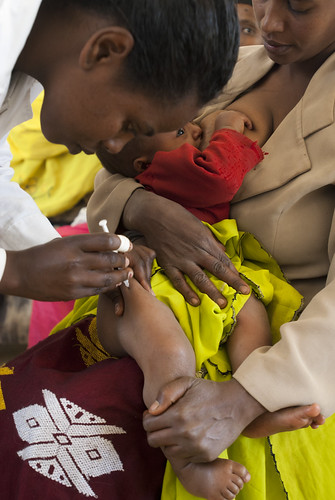ETHIOPIA
Pneumosil > ethiopia
In Ethiopia, pneumonia is a leading single disease killing under-five children

NEW YORK/Addis Ababa, 12 November 2014 – Significant declines in child deaths from pneumonia prove that strategies to defeat the disease are working, UNICEF said on the fifth World Pneumonia Day. But much more is needed to stop hundreds of thousands of children from succumbing to this preventable illness each year.
Pneumonia is still among the leading killers of children – accounting for 15 per cent of deaths, or approximately 940,000 children per year – but deaths from the disease have declined by 44 per cent since 2000, according to figures released recently by UNICEF.
“Pneumonia is still a very dangerous disease – it kills more children under five than HIV/AIDS, malaria, injuries and measles combined – and though the numbers are declining, with nearly 1 million deaths a year, there is no room for complacency,” said Dr. Mickey Chopra, head of UNICEF’s global health programmes. “Poverty is the biggest risk factor, and that means our efforts need to reach every child, no matter how marginalized.”
Deaths from pneumonia are highest in poor rural communities. Household air pollution is a major cause of pneumonia, so children from households which rely on solid fuels such as wood, dung or charcoal for cooking or heating, are at high risk. Overcrowded homes also contribute to higher pneumonia levels. In addition poor children are less likely to be immunized against measles and whooping cough, which are also among major causes of the disease.

In Ethiopia, pneumonia is a leading single disease killing under-five children. It is estimated that 3,370,000 children encounter pneumonia annually which contributes to 20 per cent of all causes of deaths killing over 40,000 under-five children every year[1]. These deaths are easily preventable and treatable through simple and cost effective interventions. Immunization, good nutrition, exclusive breast feeding, appropriate complementary feeding and hand washing are among the preventive while administration of amoxicillin dispersible
tablets and other antibiotics are among the curative methods which can save lives.
With the objective of increasing access to these lifesaving interventions, Ethiopia has made a policy breakthrough of introducing community based treatment of pneumonia through health extension workers in 2010[2].
Since then over 38,000 health extension workers from nearly 15,000 health posts are equipped with the skills and supplies to treat pneumonia at community level using the integrated community case management (iCCM) approach.[3]
Early diagnosis and treatment of pneumonia, and access to health care, will save lives, thus strategies must target low income communities.
The increased use of pneumonia vaccines, particularly in low income countries has led to progress against the disease, but inequities exist even in countries with wide coverage.
“Closing the treatment gap between the poor and the better off is crucial to bringing down preventable deaths from pneumonia,” Dr Chopra said. “The more we focus on the causes and the known solutions, the faster we will bring this childhood scourge under control.”
UNICEF’s Supply Division has today put out a call to innovators for new, improved and more easily affordable respiratory rate timers to aid in the timely recognition and management of pneumonia.
One simple treatment has had great success: trained community health workers give sick children the antibiotic amoxicillin in a child-friendly tablet form, as part of an integrated case management programme at the community level. Scaling up the availability of similar inexpensive medicines will help to reduce the treatment gap especially among hard to reach populations.
Simple measures such as early and exclusive breastfeeding; handwashing with soap; vaccination; and provision of micronutrients will also reduce the incidence of pneumonia.
[1] Fischer Walker, 2013
[2] National plan on Integrated Community Case management of common childhood illness, FMOH, 2010
[3] UNICEF, Ethiopia Central Data Base, October 2014





